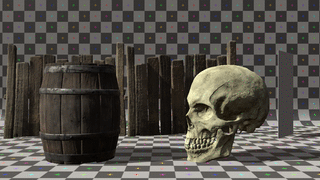This is an experimental implementation of contact shadows in Unity.
Contact Shadows is used to fill gaps between objects and shadows that are caused by shadow bias. It uses a screen-space ray tracing technique to determine regions of shadows more precisely than shadow mapping. It also employs a temporal reprojection filter to reduce processing load and artifacts caused by ray tracing.
- Unity 2017.2 or later
The Contact Shadows component only renders shadows about a specific pair of a light and a camera. You have to specify which pair of light and camera is going to be rendered with the component.
- Add the Contact Shadows component to a camera.
- Set a light to the Light property of the component.
There are three sliders in the component:
Rejection Depth - This defines depths of each pixels, which controls the thickness of shadows. It's recommended to set this value to the average thickness of the objects in the view.
Sample Count - The number of samples used per ray.
Temporal Filter - This controls the strength of the temporal reprojection filter. You can get smoother results by increasing this value, but it also introduces gaps between objects and shadows while moving the camera. It's recommended to keep the value low for fast-moving cameras. The filter is to be disabled when the value is set to zero.
- At the moment, Contact Shadows only supports directional lights.
- It's still under optimization work. It can be slow in some situations. Average GPU time is 1.5ms - 2.0ms under FHD (1080p) /w Radeon RX 480.
- The denoise filter still has room for improvement. It introduces hard-edge artifacts in worst-case situations (e.g. Grass scene).
Copyright (c) 2017 Unity Technologies
This repository is to be treated as an example content of Unity; you can use the code freely in your projects. Also see the FAQ about example contents.

